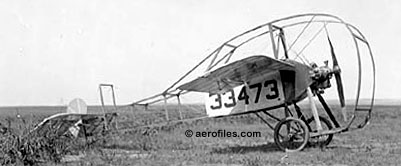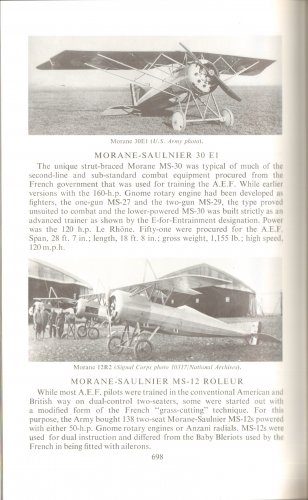Did U.S. forces in WWI (Air Service of the American Expeditionary Force or U.S. Navy or U.S. Marines) actually use any monoplanes during the period of U.S. involvement in the war (April 1917-November 1918)?
You are using an out of date browser. It may not display this or other websites correctly.
You should upgrade or use an alternative browser.
You should upgrade or use an alternative browser.
U.S. military monoplanes in WWI?
- Thread starter cluttonfred
- Start date
I have found reference to the use of the Morane-Saulnier MoS 30 by the AEF as a pursuit trainer during the war. According to the WikiP page for "Morane-Saulnier AI", 51 were supplied to the AEF.
The reference cited by the article is "Lamberton, W.M. Fighter Aircraft of the 1914-1918 War. Herts, UK: Harleyford Publications Ltd., 1960, pp. 84–85." The MoS 30 had a parasol wing.
The reference cited by the article is "Lamberton, W.M. Fighter Aircraft of the 1914-1918 War. Herts, UK: Harleyford Publications Ltd., 1960, pp. 84–85." The MoS 30 had a parasol wing.
Thanks very much, trang, that's very helpful. Your information seems to be confirmed by this old thread on The Aerodrome forum -- http://www.theaerodrome.com/forum/showthread.php?t=43197 -- in which a gentleman shared an old family photo of his wife's grandfather posed in front of just such a plane while in flight training in France with the 372nd Aero Squadron AEF. Now, the follow-up question is, does anyone have a better photo of a Morane Saulnier AI (MoS 27/29/30/30bis) in AEF service or good color scheme profile? Cheers, Matthew
- Joined
- 6 November 2010
- Messages
- 4,225
- Reaction score
- 3,152
A page from 'United States Military Aircraft since 1909' by Gordon Swanborough and Peter M Bowers, Putnam 1989.
I am not sure what is meant by the 'grass-cutting' technique in the MS-12 Rouleur item. I assume it refers to using training-craft with wings too small for flying.
I am not sure what is meant by the 'grass-cutting' technique in the MS-12 Rouleur item. I assume it refers to using training-craft with wings too small for flying.
Attachments
- Joined
- 16 April 2008
- Messages
- 8,378
- Reaction score
- 10,262
Arjen said:A page from 'United States Military Aircraft since 1909' by Gordon Swanborough and Peter M Bowers, Putnam 1989.
I am not sure what is meant by the 'grass-cutting' technique in the MS-12 Roleur item. I assume it refers to using training-craft with wings too small for flying.
http://www.wikiwand.com/en/U.S._Air_Force_aeronautical_rating
Aeronautical ratings were established on 23 February 1912, by War Department Bulletin No. 6, as a new measurement of pilot skill.[7] Before that time most pilots of the Aeronautical Division, Signal Corps soloed by the "short hop method" (also known as "grass-cutting"), in which student pilots, flying alone, learned to handle airplane controls on the ground, taxied in further practice until just short of takeoff speeds, and finally took off to a height of just ten feet, gradually working up to higher altitudes and turns. The practice resulted in the first pilot death only a month into training. At least three of these pilots had been previously instructed by Glen Curtiss at North Island field, California. Concurrently, two pilots (future General of the Air Force Henry H. Arnold and Thomas DeWitt Milling) were instructed by the Wright Brothers and certified by the Fédération Aéronautique Internationale (FAI) in July 1911.
When I saw the reference to Morane "rouleurs" (rollers) I figured that they were "penguin" ground trainers without the wing area or engine power to actually fly, something like this:

See http://www.richthofen.com/hall/hall02b.htm

See http://www.richthofen.com/hall/hall02b.htm
Similar threads
-
-
Influential Think Tank Warns Of Drop In Fighter Capability
- Started by Triton
- Replies: 4
-
-
-

